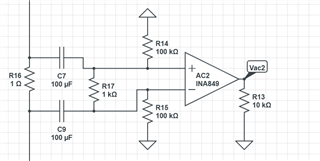Other Parts Discussed in Thread: INA848
Hello,
I have a current source driving a laser diode. I would like to measure the AC component of the drive current so that I can characterize the source's noise.
I plan to use the INA849 as shown in the image below. I am looking for any advice (even obvious stuff) as it is the first time I'll be using this component or making a circuit like this.

In the image, the source is above and the load follows below. The circuit is similar to what I see in another post: (https://e2e.ti.com/support/amplifiers-group/amplifiers/f/amplifiers-forum/1214506/ina849-frequency-response-and-the-connection-of-the-ref/4600177). I'd ground Vref. I plan to use low ESR SMT Tantalum caps; the capacitance C doesn't t roll off appreciably until > 100 kHz. Is it important that the 100 kOhm resistors be matched? I planned to use G=1000, as the datasheet says the BW is still 1.3 MHz there but would like some advice on the tradeoffs here, if any.
The output of this circuit (Vac2) would go to an o-scope for analysis (FFT etc...)
The DC current will be in the range of 0...500 mA. The noise is expected to be < 1 uA. I would like to be sensitive to at least 0.1 uV. I would like to measure signals from ~few Hz to 1 MHz ideally, but can be flexible on the top end especially. Simulating the circuit above seem to show the desired frequency response.
Thanks for any pointers.




